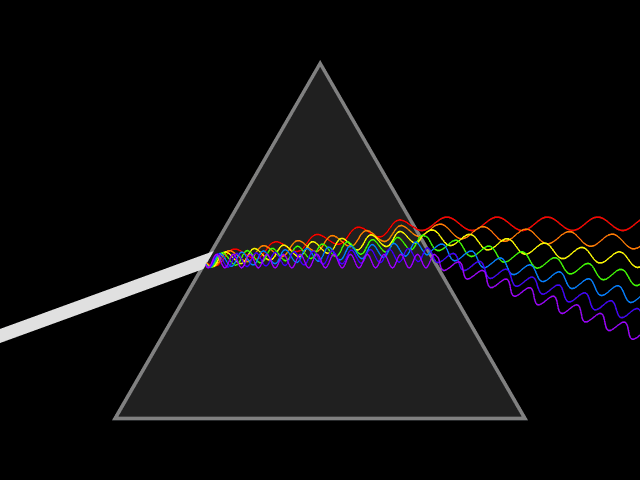File:Light dispersion conceptual waves.gif
外觀
Light_dispersion_conceptual_waves.gif (640 × 480 像素,檔案大小:1.14 MB,MIME 類型:image/gif、循環、90 畫格、4.5秒)
檔案歷史
點選日期/時間以檢視該時間的檔案版本。
| 日期/時間 | 縮圖 | 尺寸 | 用戶 | 備註 | |
|---|---|---|---|---|---|
| 目前 | 2010年4月6日 (二) 17:09 |  | 640 × 480(1.14 MB) | Kalki | Reverted to version as of 04:14, 27 February 2008 |
| 2010年4月6日 (二) 17:07 |  | 640 × 480(1.17 MB) | Kalki | Reverted to version as of 03:31, 27 February 2008 | |
| 2008年2月27日 (三) 04:14 |  | 640 × 480(1.14 MB) | LucasVB | ||
| 2008年2月27日 (三) 03:31 |  | 640 × 480(1.17 MB) | LucasVB | {{Information |Description=Copnceptual animation of dispersion of light in a prism. Using waves. |Source=self-made |Date=2008-02-27 |Author= Lucas V. Barbosa (aka Kieff) |Permission=Public domain |other_versions=Light_dispersion_conceptual. | |
| 2007年12月24日 (一) 04:10 |  | 640 × 480(348 KB) | LucasVB | {{Information |Description=Dispersion of light inside a prism. Now with waves. |Source=Self |Date=2007-12-24 |Author=Lucas V. Barbosa |Permission=Public Domain |other_versions=Image:Light_dispersion_conceptual.gif }} |
檔案用途
下列2個頁面有用到此檔案:
全域檔案使用狀況
以下其他 wiki 使用了這個檔案:
- af.wikipedia.org 的使用狀況
- am.wikipedia.org 的使用狀況
- ar.wikipedia.org 的使用狀況
- ary.wikipedia.org 的使用狀況
- ast.wikipedia.org 的使用狀況
- as.wikipedia.org 的使用狀況
- azb.wikipedia.org 的使用狀況
- az.wikipedia.org 的使用狀況
- ba.wikipedia.org 的使用狀況
- bcl.wikipedia.org 的使用狀況
- bg.wikipedia.org 的使用狀況
- bn.wikipedia.org 的使用狀況
- bn.wikiquote.org 的使用狀況
- bs.wikipedia.org 的使用狀況
- ca.wikipedia.org 的使用狀況
- ceb.wikipedia.org 的使用狀況
- cs.wikipedia.org 的使用狀況
- cy.wikipedia.org 的使用狀況
- da.wikipedia.org 的使用狀況
- el.wikipedia.org 的使用狀況
- en-two.iwiki.icu 的使用狀況
檢視此檔案的更多全域使用狀況。



